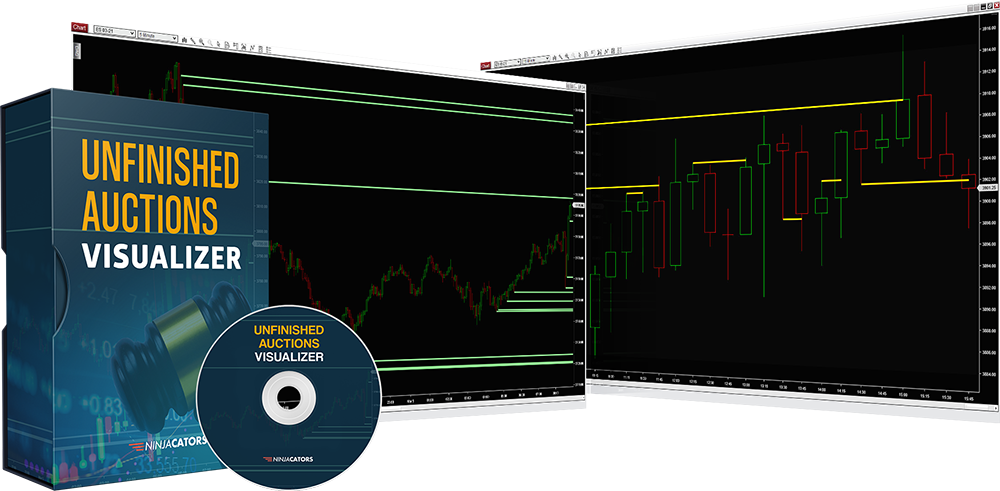Welcome to Ninjacators eBook on
‘How To Profit From Unfinished Auctions’
[Chapter 1]
Don’t worry, it’s not a slump…
(It’s much, much worse)
The worst batter in the history of baseball. A distinction no ball player would ever want tied to their name. In 1909 Dodger (not-so-great) Bill Bergen laid claim to that title and managed to hang on to it for over 100 years. He walked to the plate and sat back down again without a base hit in 46 consecutive at-bats. Even the pitchers had a better batting average than Bill. Talk about futility.

Yet, every day millions of futures traders face similar results.
They leave their market with nothing to show for their effort but a cleared account. Or even worse, they actually manage to make a handful of winning trades. Not enough to break even – but just enough to make them believe they have a chance. This leads to further investment in a lost cause that will only increase their losses and disappointment.
If you’re like the millions of ‘Bill Bergen’ futures trades out there – struggling to make money – perhaps you’re ready to throw in the towel. You probably spend hours watching your market and studying charts like a hawk. Your indicators are fine-tuned with care and precision. Yet when you head to the plate to take a crack at a trade, you don’t know you’ve already lost before you can even take a swing.
You’re not just in a slump. Nope. In this case, you can take comfort in knowing that just about everything you’re doing is wrong.
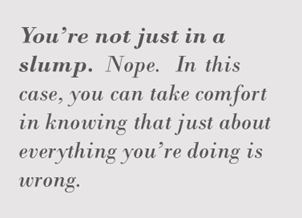
The reason why you’re not succeeding is painfully simple: You likely believe you’re trading in a market where price action determines the winners and losers. Most educators and indicators do nothing but reinforce this belief.
With each candle, you’re actually in an auction. One where the unmatched institutional buying and selling forces will determine your fate. These forces are unseen (and overlooked) by most – except for a select few.
The traders who understand this are the ones that win big, and win consistently. They know what to watch, where to enter and where to exit.
Here’s a shocker: They could care less about price action.
[Chapter 2]
The LAST thing you should watch…
(Yet 95% of traders can’t get enough of it)
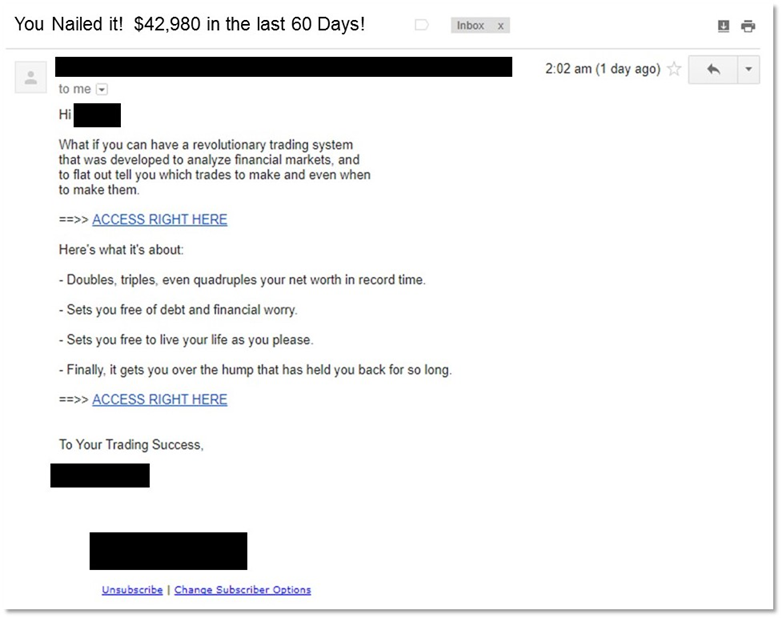
If you’ve been hoping to land profits by predicting where price will go you’re in good company. That’s exactly what 95% of (losing) retail traders do.
Check your spam filter. Among the hundreds of emails promising you that financial independence is just a ‘class’ or an ‘indicator’ away – you’ll find a common theme. They’re ALL focused on price action (if anything at all).
In reality, this is the LAST element you want to watch. Especially at a two-way auction where multiple buyers and sellers are going at it.
Price action indicators, especially those that claim to give you reliable green buy or red sell arrows have one deadly flaw. They only tell you what just happened. Not what’s about to happen.
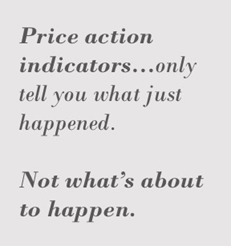
This is because they attempt to translate the elements of price action – like open, close, highs and lows – into entries and exits for trades. This supposed ‘intelligence’ is hopelessly late. By the time you get in, everyone has moved on.
Imagine sitting at a live auction, paddle in hand, trying to make a move only knowing what everyone else knows. Trading with price action in a market auction is as good as heading into a position blindfolded.
Without the ability to see what’s really happening – you simply follow the noise. Effectively moving with the herd, scared and second-guessing yourself with every step.
Despite what those emails clogging your spam filter say, you’ll always be late and you’ll almost always lose. With this approach, you’re chasing profits, with no consistent way to compete and take them.
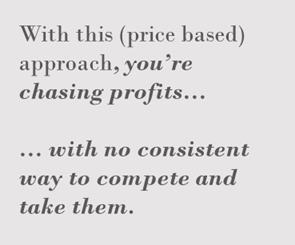
Don’t despair. There are traders who consistently profit at these auctions.
These are the top 5% (or less) who understand they’re working with a TWO-WAY auction. They know exactly what’s happening between the multiple buying and selling forces that are moving simultaneously.
As a result, they know the auction moments to watch for in EVERY futures market. But since they’re not watching price – what are they watching? More importantly, WHO are they watching?
Simple. They’re tracking the buyers and sellers with the real power. These are the institutional traders that drive 95% of the total volume.
They control this volume while laughing at the retail suckers who obliviously hand over their money with every trade.
[Chapter 3]
The guys who make all the money…
(Yep, they’re laughing at you too)

Picture any auction you’ve ever seen or been to. There’s always a start, followed by a frenzied finish. You know somebody in the room knows exactly what’s going on. It’s just not you (yet).
But the room is filled with both buyers and sellers. There’s a ton of activity. You’re doing your best to ignore price, but it’s all over the place. You want desperately to be in the ‘winning 5%’. How do you spot the people to follow?
Well, it’s NOT the couple from Ohio waving their paddle in the air screaming buy and sell orders every second. They’re the equivalent of the retail traders who enter the market every second with a small trade hoping to snag a buck. They’ll either overpay, pass out from excitement – or both. But they’re not going to change the outcome of the auction. Your price-based indicator falls for these folks every time.
IT’S THE GUY WAITING in the back of the room quietly whispering to a colleague. Don’t take your eyes off that one. These are the players who determine the fate of an auction. They have an accurate sense of market value and make their buy and/or sell moves based on the likely outcome – not the current price. They know that price is just the current score.
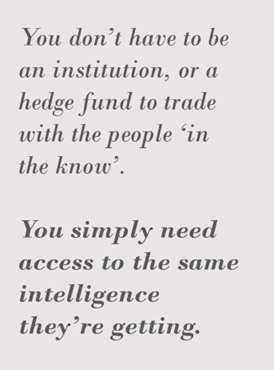
In a market auction, these are the traders who make all the money. They know the institutions are in control and have very specific conditions they’re looking for before making a move. Never suckered into the frenzy, they know exactly what’s going on between buyers and sellers.
Here’s the good news: You don’t have to be an institution, or a hedge fund, to trade with the people ‘in the know’. You simply need access to the same intelligence they’re getting.
This intelligence makes the auction conditions you’re looking for very simple and easy to spot.
For instance, in a two-way market auction, every buyer needs a seller. And vice versa. In theory an auction isn’t supposed to finish until everyone settles up at the end – both buyers and sellers.
But sometimes there’s a gap. A period when somebody gets left hanging.
This temporary opening creates the exact type of opportunity the ‘winning 5%’ in the back of the room are looking for.
It’s time to wipe that smirk off their face.
[Chapter 4]
An immediate opportunity to profit…
(When traders are left hanging)
Unfinished business. It’s an age-old theme that has caused gun duels and started wars. When somebody is jilted or left holding the bag – people tend to notice and take exception. The market is no different.
Especially when buyers or sellers are left hanging with no counter-party to pick up the other side of their trade at the end of an auction. Remember that each candle, regardless of timeframe, is a market auction.
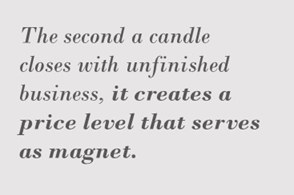
If there are buyers or sellers unable to finish their business at the close of a candle, you have a moment that can’t be ignored.
Welcome to an Unfinished Auction. An immediate profit opportunity that the ‘5% club’ has been tapping from the back of the room all along.
Fine. So you like good drama but love profits even more? Good. Here’s why you should be looking for unfinished auction trading: The second a candle closes with unfinished business, it creates a price level that serves as a magnet.
Check out this ES chart. Ever wonder why price ventures up to a certain level and then turns around – seemingly out of nowhere? It’s not magic. The market hasn’t been inspired to somehow make a move and then reverse. It’s not your dad’s classic support and resistance patterns either.
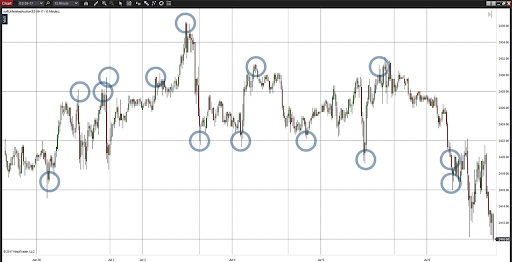
It’s unfinished business. The moments where powerful buyers and sellers have been left hanging. They won’t be stood up. Price will return. Now let’s take a look at these same candles’ auctions from the perspective of the ‘profitable 5%’.
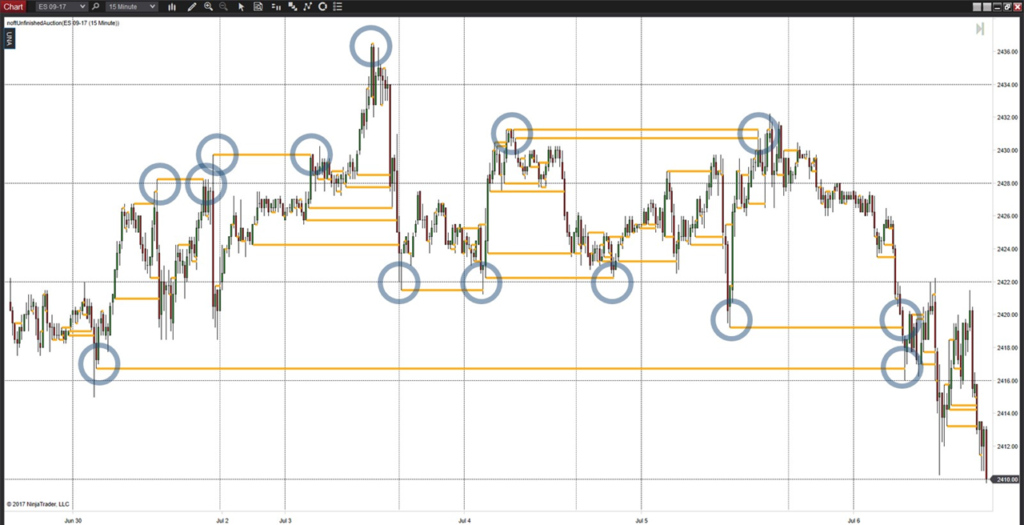
It’s hard to miss once you see it. The gold bars tie the candles that initially closed with unfinished auctions with the candles that resolved them later on. To say that price has a healthy respect for these levels is an understatement.
The pull of these price levels can’t be ignored because the market has a natural need to resolve unfinished business. When these moments surface, they become pivotal points that you can stalk for a reversal trade.
Now imagine finally being able to know what levels you should be watching… in advance… thanks to an unfinished auction that just took place.
You could take years to study candle tips. You could attempt to cobble together different systems.
Or you could just have it plotted on your chart the second it happens.
[Chapter 5]
The best seat in the house…
(Where it all goes down)
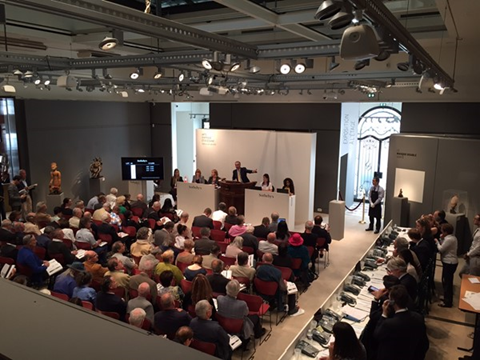
If you’re a first-time buyer at a high-end auction, the house will always make sure there’s an open seat. Rest assured, it will likely be in the very front, supposedly so you can get the best view of every item that’s up for bid. Or… so they don’t miss a single bid you make.
Either way, don’t be flattered. At least you won’t see the pros behind you snickering as you offer to pay a 30% premium with every bid you make.
[Caption: ]
What you really want is a spot that gives you a view of the overall auction. The same one the pros take from the back, or sides, of the room. A futures market auction is no different – especially when you’re looking for unfinished auction trading.
This is EXACTLY why the Unfinished Auction Visualizer was created. The second a candle wraps up with unfinished business at the close – that price level is marked for you. It’s almost as though the offended party has raised his or her hand signaling that they’ve been left hanging.
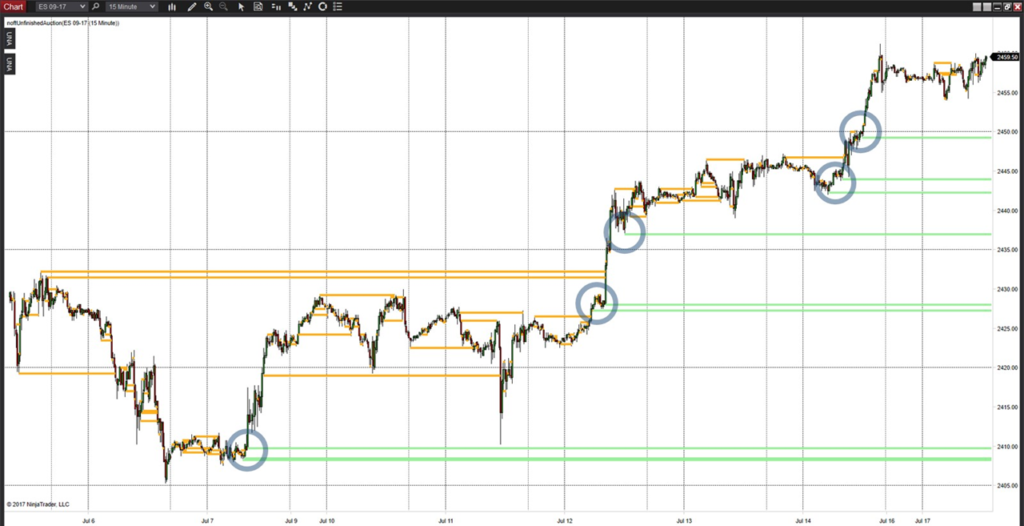
It’s these very price levels that you want to watch. At that point, price can pretty much do whatever it wants. You just have to wait for it to approach and plot your move. Looking at the ES again, you’ll see that the unresolved Unfinished Auctions have been added – with the levels you want to monitor plotted in green.
These are exactly the moments that consistently profitable traders are looking for. The type of intelligence that affords them a glimpse into what the market is about to do – not what it just did.
Now you’re presented with a very easy decision: You can flail your arms in the air, trading every micro-swing, hoping to snag a profit – like our friends from Ohio. Or you can sit back and wait for price to reach that level – settle the unfinished auction – and then fade/reverse back.
One approach will do nothing but tire you out – and deliver the same results you’ve seen to date. The other will refresh your account with profits and confidence with half (if that) the effort.
Give yourself a chance by trading the market’s auction with those in the know. Use the Unfinished Auction Visualizer to stalk price levels where you have the best chance of seeing a reversal.
Do so with confidence, knowing that you’re basing your entry on actual market intelligence. See price action for what it is: a distraction that 95% of the retail trading public falls for.
Take your profits with the ease of a seasoned pro while the 5% club wonders how another one got in.
Click the Download Button Below to save your FREE copy of this eBook

